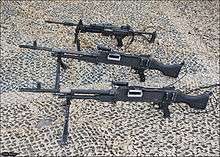General-purpose machine gun

A general-purpose machine gun (GPMG) is an air-cooled, belt-fed weapon with a quick change barrel that can be used in a variety of roles, from bipod- or tripod-mounted infantry support, to deployment as a helicopter door gun, or a vehicle-mounted support weapon.[1] Modern GPMGs fire full-power rifle cartridges such as the 7.5×54mm French, 7.5×55mm Swiss, 7.62×51mm NATO, 7.62×54mmR, 7.92×57mm Mauser, etc.
History
"With the MG 34, the German Wehrmacht introduced an entirely new concept in automatic firepower - the Einheitsmaschinengewehr general-purpose machine gun (GPMG).[2][3][4] In itself the MG 34 was an excellent weapon: an air-cooled, recoil-operated machine gun that could run through belts of 7.92×57mm Mauser ammunition at a rate of 850 rounds per minute, delivering killing firepower at ranges of more than 1,000 meters.[3][4] Yet simply by changing its mount, sights and feed mechanism, the operator could radically transform its function. On its standard bipod it was a light machine gun, ideal for infantry assaults; on a tripod it could serve as a sustained-fire medium machine gun; aircraft or vehicular mounts turned it into an air defence weapon; and it also served as the coaxial machine gun on numerous tanks.[3][4]
During World War II, the MG 34 was superseded (although it remained in combat use) by a new GPMG - the MG 42.[5][6][7] The MG 42 was more efficient to manufacture and more robust, and had a blistering 1,200 rounds per minute rate of fire.[5][6][7] Nicknamed 'Hitler's buzzsaw' by Allied troops, it was arguably the finest all-round GPMG ever produced, and alongside the MG 34 it inflicted heavy casualties on Allied soldiers on all European and North African fronts.[5][7][8] Such were its qualities of firepower and usability that it became the foundation of an entire series of postwar machine guns, including the MG 1 and MG 3 - the latter is still in production and service to this day."[5][6][7][9]
The MG 34 and MG 42 influenced many post-World War II general purpose machine guns, many of which are still in use today. It lent design elements to the Belgian FN MAG and the American M60, while spawning the Zastava M53, Swiss M51, and Austrian MG 74.
Notable post-WWII examples
- German MG 3, a direct descendant of the MG 42, is still in service with the German Army and others.
- Belgian FN MAG, which copied the MG42's feed-system and trigger-mechanism.[10] It is the most widely used GPMG among western armies.
- American M60, which uses the MG42's feed-system and stamp-steel construction.[11][12] It has been replaced in U.S. service by the M240, itself an FN MAG variant.
- French AA-52, which more or less copies the MG42 feed-system.[13] It has been largely phased out in favour of the FN MAG and FN Minimi.
- Russian PK/PKM family of multi-purpose machine-guns, widely exported.
- People's Republic of China, the Type 67 and later improved models.
- German Heckler & Koch HK21, based on the Heckler & Koch G3 rifle and widely exported
- Swiss MG 51, a direct descendant of the MG 42.
- German Heckler & Koch MG5, the new standard machine gun of the German Army
Gallery
 MG34 belt-fed tripod version (top) and saddle-drum magazine bi-pod version (below)
MG34 belt-fed tripod version (top) and saddle-drum magazine bi-pod version (below) MG42 (top) & StG 44 (below)
MG42 (top) & StG 44 (below) MG3 on display
MG3 on display
 FN MAG GPMG
FN MAG GPMG An M60 machine gun
An M60 machine gun AA-52
AA-52- PKM general-purpose machine gun
 The Type 67 on a tripod field mount.
The Type 67 on a tripod field mount. American M240
American M240 Russian Pecheneg
Russian Pecheneg HK21A1 general-purpose machine gun
HK21A1 general-purpose machine gun
See also
References
- ↑ Archived January 10, 2013, at the Wayback Machine.
- ↑ Jane's Guns Recognition Guide. Ian Hogg & Terry Gander. HarperCollins Publishers. 2005. page 375
- 1 2 3 Military Small Arms of the 20th Century. 7th Edition. Ian V. Hogg & John S. Weeks. Krause Publications. 2000. page 326
- 1 2 3 The Encyclopedia of Weapons of World War II. Chris Bishop. Sterling Publishing Company. 2002. page 245 & 246
- 1 2 3 4 Jane's Guns Recognition Guide. Ian Hogg & Terry Gander. HarperCollins Publishers. 2005. page 376
- 1 2 3 Military Small Arms of the 20th Century. 7th Edition. Ian V. Hogg & John S. Weeks. Krause Publications. 2000. page 329
- 1 2 3 4 The Encyclopedia of Weapons of World War II. Chris Bishop. Sterling Publishing Company. 2002. page 247
- ↑ Military Small Arms of the 20th Century. 7th Edition. Ian V. Hogg & John S. Weeks. Krause Publications. 2000. page 328 & 329
- ↑ MG 34 and MG 42 Machine Guns. by Chris McNab. Published by Random House Publishing Group. Oct 23, 2012. Quote taken from leaf.
- ↑ "Modern Firearms - FN MAG". World.guns.ru. Retrieved 2012-07-30.
- ↑ Military Small Arms Of The 20th Century. Ian Hogg & John Weeks. Krause Publications. 2000. p379
- ↑ Weapons: An International Encyclopedia From 5000 B.C. To 2000 A.D. Diagram Visual, p. 217. ISBN 0-312-03950-6.
- ↑ Modern Firearms - AAT Mod.52